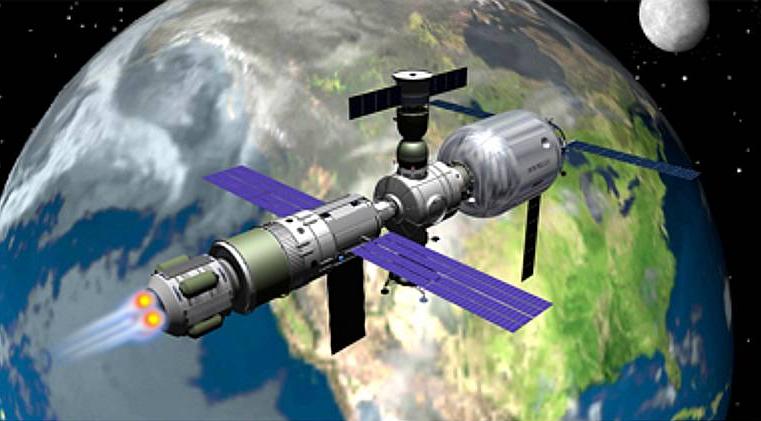Space.com Heliosphere Explorer 1 (SHE-1) (edit 2009.08.30)
_____________________________________________________________________
1. Lander:
Start with
Altair (Lunar lander), keep it in one piece (
SSTO), apply
COTS tricks to lower cost.
2. Habitation and logistics:
1x
BA330, 1x
ISS Node-1, 2x
ISS PMA
3. Power source (20 MW or 20 000 kW for engines)
a.) use RTG
- RTG generator
- cooling radiators
b.) use PV
- PV cells
- batteries
4. VASIMR, fuel
- 20t argon fuel tank for 80t of argon
- 4x VX-5000
5. Supplies, instrumentation, science (edit 2009.08.31)
- 20t supplies for 6 people for 6 months
- 40t instrumentation, science, for first evaluation
____________________________________________________________________
1. = 20t
2. = 40t
3a. - using HPM (1MWe/t, text in reference speculates it could work in space, heat sink?) =
20t
3b. - using SAFE-6400 (0,083MWe/t, heat sink?) = 16 * (16 * SAFE-400) = 16 * 20t =
320t
3c. - using Solaren PV (0,72 MWe/t) =
60t (check above discussion)
- batteries or fuel cells ?
4. - 20t fuel tank + 80t fuel =
100t
- 4x VX-5000 = 4 * (25 * VX-200) = 4 * 10t =
40t
- heat sink = ?
5. 20t + 40t =
60t
(edit 2009.09.30, added equation)
http://en.wikipedia.org/wiki/Rocket_equation
Isp = 5000
Ve = Isp * g = 5000 s * 10 m/s^2 = 50km/s (edit 2009.08.31, changed g0 to g, added * multiplication symbol)
dV = Ve * ln (m1/m2)
Options:
(using rocket equation,
Isp = 5000)
3a.) 20t + 40t + 20t + 100t + 40t + 60t = 280t, delta V =
16,8 km/s
3b.) 20t + 40t + 320t + 100t + 40t + 60t = 580t, delta V =
7,4 km/s
3c.) 20t + 40t + 60t + 100t + 40t + 60t = 320t, delta V =
14,4 km/s
(using rocket equation,
Isp = 10000) (edit 2009.08.31, calculations for Isp 10000)
3a.) 280t full (m1), 200t empty (m2), delta V = 33647,22 m/s =
33,65 km/s
3b.) 580t full, 500t empty, delta V =
14,84 km/s
3c.) 320t full, 240t empty, delta V =
28,77 km/s
(using rocket equation,
Isp = 30000) (edit 2009.09.01)
3a.) delta V =
99 km/s
3b.) delta V =
43 km/s
3c.) delta V =
84,7 km/s
Thrust assuming 60 % efficiency for 4x VX-5000 (edit 2009.09.01, expected efficiency around 80 %)
Isp
1000s =
20000 kW * 0,6 / (1000s * 9,81 m/s^2) =
1220 N (not in operational range of VASIMR)
Isp
5000s = 245 N
Isp
10000s = 122 N
Isp
30000s = 41 N
(edit 2009.08.30, added burn time)
Burn time, assuming 80t argon, using equation
(fuel * Isp * g)/thrust, numbers are approximate :
Isp
1000s = 7 days (not in operational range of VASIMR)
Isp
5000s = 189 days
Isp
10000s = 758 days
Isp
30000s = 6646 days (18+ years)
_______________________________________________________________
We are missing info on heat sink (8 MWt for engines), batteries/fuel cells and radiation shielding mass. I am also avoiding cost discussion until we have stable hardware configuration.
I'm still checking the list, please comment.
______________________________________
Here are some links for reference: (edit 2009.09.01, references)
I have some assumptions about size and mass of heat sinks, but no real data yet, using this page:
http://en.wikipedia.org/wiki/Thermal_radiation
(2009 U.S. Commercial Space Transportation Developments and Concepts:
Vehicles, Technologies, and Spaceports January 2009)
http://www.faa.gov/about/office_org/hea ... 202009.pdf
Reference Guide to the International Space Station :
http://www.nasa.gov/mission_pages/stati ... Guide.html
VASIMR article on Wikipedia with lots of links:
http://en.wikipedia.org/wiki/VASIMR
This document includes information about maximum possible Isp in 30 000s range.
I have received email from Ad Astra Rocket,
confirming operational Isp range from 5000s - 30000s
(edit 2009.09.02)
(VASIMR Plasma Rocket Technology)
http://dma.ing.uniroma1.it/users/bruno/Petro.prn.pdf
About nuclear option:
Seven of the nuclear generators would provide 200 MW of power to enable 39 day one way trips to Mars.
(November 28, 2007 - Vasimr engines plus 200 MW of nuclear "batteries" = 39 days to Mars )
http://nextbigfuture.com/2007/11/vasimr ... clear.html
Hyperion Power Module information:
http://www.hyperionpowergeneration.com/product.html
Link on Wikipedia to get specific energy for SAFE-400
http://en.wikipedia.org/wiki/SAFE-400
Some past projections:
(Future NASA Multi-kilowatt Free Piston Stirling Applications)
This paper describes the preliminary work that will be performed toward development of a nuclear-fission-powered nominal 30 kW Stirling power system for use on the lunar surface with a specific power goal of about 140 W/kg for the Stirling power conversion system.
http://sri.auburn.edu/papers/2006/futur ... irling.pdf
Solar alternative:
(Stretched Lens Array SquareRigger (SLASR): A New Space Array for High-Power Missions)
http://www.stretchedlensarray.com/Paper ... WCPEC4.pdf
· Areal Power Density = 300 - 400 W/m2
· Specific Power = 300 W/kg - 500 W/kg
· Stowed Power = 80 - 120 kW/m3
· Scalable Array Power = 4 kW to 100’s of kW’s
· Super-Insulated Small Cell Circuit = High-Voltage (300-
600 V) Operation at Low Mass Penalty
· Super-Shielded Small Cell Circuit = Excellent Radiation
Hardness at Low Mass Penalty
· 85% Cell Area Savings = 66% to 75% Lower Array Cost
per Watt than One-Sun Array
· Modular, Scalable, & Mass-Producible at MW’s per Year
Using Existing Capacities
Orbital Data for the Planets & Dwarf Planets :
http://www.windows.ucar.edu/tour/link=/ ... table.html
Conceptual Mars mission using 3 VASIMR engines (SHE has 100):
[youtube]http://www.youtube.com/watch?v=Zj53rVWK5z0[/youtube]



